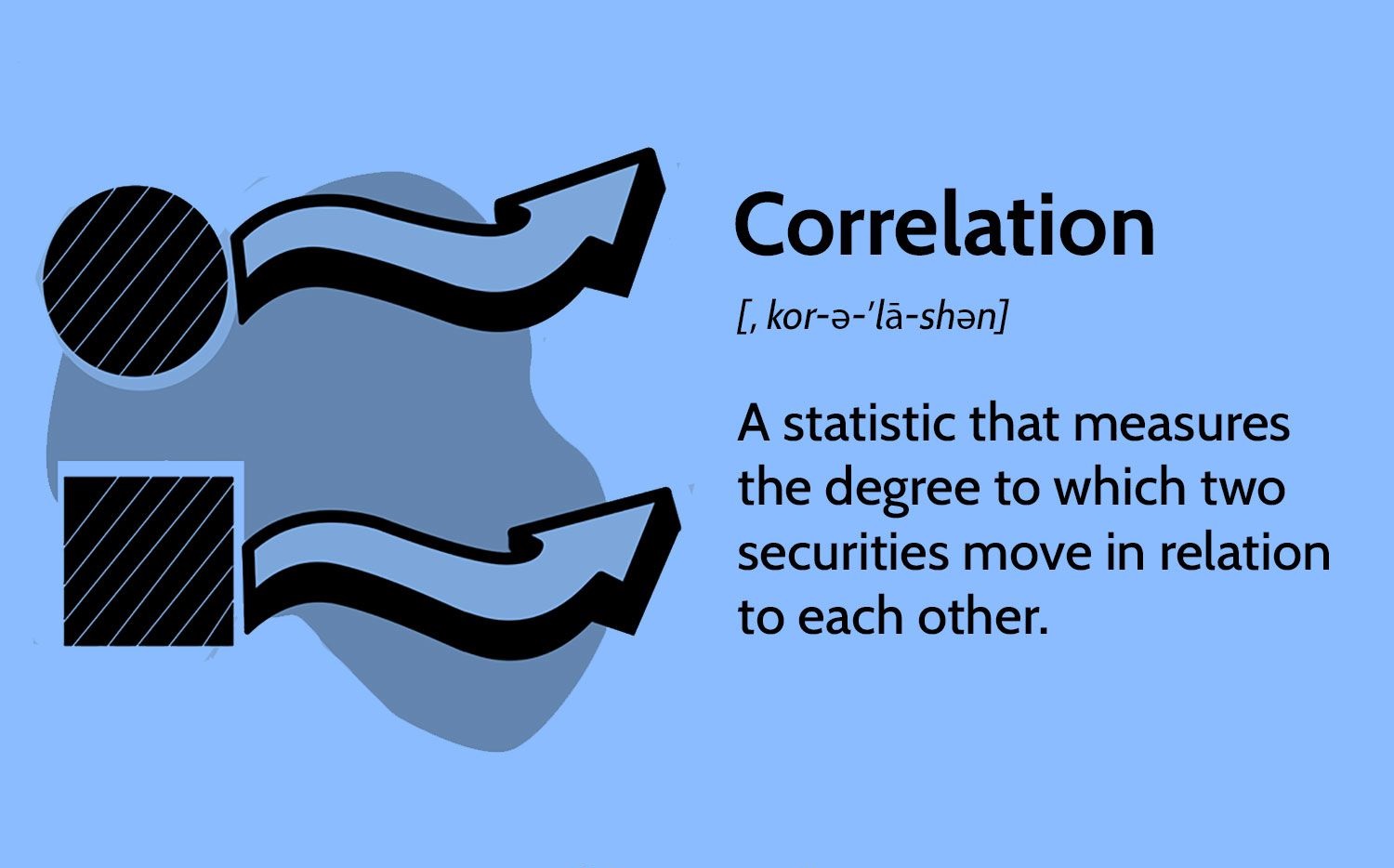Introduction
Investing is a crucial aspect of personal finance as it allows individuals to grow their wealth and achieve their financial goals. However, making informed investment decisions requires a deep understanding of the factors that contribute to investment performance. Various elements affect investment outcomes and can be used to gauge the potential risks and rewards associated with different investment opportunities.
In this article, we will explore the important factors that are correlated with investments. By analyzing these factors, investors can gain valuable insights to make more informed decisions and navigate the complexities of the financial markets.
Understanding the correlation between investments and various factors is essential because it enables investors to anticipate and navigate market movements. By identifying the key factors that influence investment performance, investors can adjust their strategies accordingly and potentially improve their chances of success.
It is important to note that while these factors can provide valuable insights, they do not guarantee investment success. The financial markets are inherently unpredictable, and other unforeseen factors can also impact investment outcomes. However, by considering these correlated factors and conducting thorough research, investors can position themselves for better potential returns and minimize risks to some degree.
In the following sections, we will delve into the key factors that are closely correlated with investments. These factors encompass both macroeconomic variables and industry-specific indicators, providing a comprehensive perspective on the different influences on investment performance. Let’s explore!
Economic Factors
Economic factors play a significant role in determining investment performance. The overall health of the economy, including economic growth, employment levels, and income levels, can influence the profitability of investments.
One crucial economic factor is Gross Domestic Product (GDP), which measures the value of all goods and services produced within a country’s borders. When GDP is growing, it indicates a healthy economy, which generally leads to increased corporate profits and higher investment returns. On the other hand, a decline in GDP can signal a recession, which may result in decreased investment opportunities and lower returns.
Another important economic factor to consider is the unemployment rate. A low unemployment rate often signifies a robust labor market, where more people have jobs and disposable income to invest. Conversely, a high unemployment rate can indicate a weakened economy with reduced consumer spending and lower investment demand.
Inflation is another economic factor that significantly impacts investments. Inflation refers to the general increase in prices over time, reducing the purchasing power of money. High inflation erodes the value of investments, particularly fixed-income assets such as bonds. Investors must account for inflation when making investment decisions to ensure that their portfolios can keep pace with rising prices.
Interest rates are closely tied to the overall economic health and affect investment performance. When interest rates are low, it becomes cheaper for businesses to borrow money, leading to increased investments and potentially higher returns. Conversely, higher interest rates can make borrowing more expensive, reducing investment demand and potentially dampening returns.
Government fiscal and monetary policies also influence investment performance. Government spending, tax policies, and regulations can impact specific industries and sectors, creating investment opportunities or challenges. Monetary policies, such as central bank actions regarding interest rates and money supply, can also influence investment markets and asset prices.
It is important for investors to stay informed about economic indicators and trends through economic reports, news, and analysis. By monitoring economic factors, investors can identify potential investment opportunities and position themselves for success in various economic conditions.
Market Conditions
The state of the financial markets, also known as market conditions, has a direct impact on investment performance. Market conditions refer to the supply and demand dynamics of various asset classes, including stocks, bonds, commodities, and real estate.
One crucial market factor to consider is market volatility. Volatility refers to the degree of price fluctuations in the market. Higher volatility can present both opportunities and risks for investors. While it can lead to greater potential returns, it also increases the likelihood of significant losses. Understanding and managing volatility is essential in mitigating risks and maximizing investment gains.
Another key market condition to monitor is the overall trend of the market. Markets can be in various states, such as bull markets, characterized by extended periods of rising prices, or bear markets, marked by prolonged periods of declining prices. The direction of the market can impact investment decisions, as different asset classes perform differently in different market cycles.
Liquidity is also an important market condition to consider. Liquidity refers to the ability to buy or sell an asset quickly and at a fair price. Highly liquid markets, such as major stock exchanges, provide better opportunities to enter or exit investments smoothly. Illiquid markets, on the other hand, can pose challenges in executing investment transactions and may result in higher transaction costs.
Market sentiment or investor psychology is another critical factor affecting market conditions. Investor sentiment can swing between optimism and pessimism, driving market movements. Positive sentiment can lead to increased investments and higher asset prices, while negative sentiment can trigger sell-offs and declining prices. Understanding investor sentiment can provide insights into potential market trends and help guide investment decisions.
It is important for investors to stay informed about market conditions through market analysis, news, and technical indicators. By monitoring market conditions, investors can identify investment opportunities, adapt their strategies to prevailing market trends, and make informed decisions about asset allocation and timing.
Industry Performance
The performance of specific industries can have a significant impact on investment returns. Different sectors and industries experience varying levels of growth, profitability, and market dynamics, which directly influence the performance of companies within those sectors and, consequently, investors’ returns.
Understanding industry performance involves analyzing factors such as demand and supply trends, technological advancements, regulatory changes, and competitive dynamics. Industries that are experiencing rapid growth and have favorable market conditions often present attractive investment opportunities.
Investors should keep an eye on industry-specific indicators and trends, such as sales growth, market share, and profitability ratios, to gauge the performance of companies operating within those industries. Additionally, following industry news, reports, and expert analysis can provide valuable insights into the opportunities and challenges facing specific sectors.
It is important to diversify investments across different industries to mitigate risks. Investing in multiple sectors helps spread risks and allows investors to benefit from potential growth in various areas of the economy. Analyzing industry performance and identifying sectors with strong growth potential can guide investors in allocating their investments strategically.
However, it is essential to note that industry performance can be cyclical, with industries going through periods of growth and contraction. Therefore, understanding the dynamic nature of industries and monitoring their performance regularly can help investors adjust their portfolios accordingly and capitalize on prevailing trends.
Investors can keep track of industry performance through industry reports, market research, financial news, and expert opinions. By staying informed about industry-specific factors, investors can make more educated investment decisions and position themselves to take advantage of opportunities within thriving sectors.
Company Profitability
The profitability of individual companies is a key factor that directly impacts investment performance. The financial health and profitability of a company are essential indicators of its ability to generate returns for investors.
Profitability can be assessed through various financial metrics, such as gross profit margin, operating profit margin, and net profit margin. These metrics provide insights into the company’s ability to generate profits from its operations and control expenses.
Investors should evaluate a company’s profitability relative to its industry peers and benchmark performance. A company with consistently high profitability may be more attractive to investors as it may have a competitive advantage, strong management, and a sustainable business model.
Examining a company’s financial statements, such as its income statement and balance sheet, can provide deeper insights into its profitability. It is important to analyze factors such as revenue growth, cost management, and profit sustainability over time.
Investors should also consider the quality of earnings when assessing company profitability. High-quality earnings are those that are sustainable and generated through core business operations rather than one-time events or accounting adjustments. Accurate and transparent financial reporting is crucial in evaluating the true profitability of a company.
Additionally, investors should look beyond current profitability and consider the potential for future growth. Companies with strong profitability may reinvest their profits into research and development, expanding their product offerings, or entering new markets. These investments can pave the way for future growth and potentially increase their profitability over time.
It is important to note that profitability is not the sole determinant of investment success. Other factors, such as industry trends, market conditions, and overall economic factors, can also significantly impact investment performance. Therefore, it is crucial to consider profitability in conjunction with other relevant factors when making investment decisions.
Evaluating company profitability requires thorough research and analysis. Investors can refer to financial statements, analyst reports, industry research, and company announcements to assess profitability and make informed investment decisions.
Interest Rates
Interest rates have a profound impact on investment performance. They influence borrowing costs, investment returns, and the attractiveness of different investment options.
When interest rates are low, borrowing becomes more affordable, encouraging individuals and businesses to take on debt for investment purposes. Lower borrowing costs can stimulate economic growth and increase demand for assets such as stocks and real estate. As a result, investments in these assets may experience higher returns during periods of low interest rates.
Conversely, when interest rates are high, borrowing becomes more expensive, which can discourage investments and potentially lower investment returns. Rising interest rates can also lead to a decrease in demand for certain assets, causing their prices to decline.
Fixed-income investments, such as bonds and certificates of deposit (CDs), are particularly sensitive to interest rate changes. When interest rates rise, the value of existing fixed-income investments decreases, as newly issued bonds or CDs offer higher returns. On the other hand, when interest rates fall, existing fixed-income investments become more valuable, as they provide higher returns compared to newly issued bonds or CDs.
Investors should also consider the impact of interest rates on inflation. Higher interest rates are often used by central banks to curb inflation. When interest rates rise, borrowing becomes more expensive, leading to reduced spending and potentially lower inflation rates. On the other hand, lower interest rates can stimulate economic growth and increase inflationary pressures.
It is important for investors to monitor interest rate trends and assess their potential impact on different investment types. By considering the prevailing interest rate environment, investors can make informed decisions about asset allocation, debt management, and the suitability of various investment options.
Various factors influence interest rates, including government monetary policies, inflation expectations, and overall economic conditions. Investors should stay updated on central bank announcements, economic indicators, and financial news to track interest rate trends and make timely investment decisions.
Inflation
Inflation is an important economic factor that significantly impacts investment performance. It refers to the general increase in prices of goods and services over time. Understanding the impact of inflation is essential for investors to preserve the purchasing power of their investments and achieve their financial goals.
One key aspect of inflation is its erosion of the value of money. As prices rise, the same amount of money can buy fewer goods and services, reducing the purchasing power of individuals. This erosion of purchasing power affects both consumers and investors.
Inflation affects different investments in various ways. Fixed-income investments, such as bonds and cash deposits, are particularly vulnerable to inflation. When inflation rises, the fixed interest payments of bonds may have less purchasing power, leading to decreased returns in real terms. Similarly, cash deposits may lose value over time, as the interest earned may not keep up with inflation.
On the other hand, certain investments can act as a hedge against inflation. Some assets, such as real estate and certain commodities like gold and oil, have historically shown the potential to maintain or increase in value during inflationary periods. These assets are often considered as “inflation hedges” as their prices tend to rise alongside inflation.
Additionally, equities or stocks have the potential to outperform inflation. Companies can pass on increased costs to consumers through higher prices, leading to potentially higher profits. However, it is important to note that not all stocks perform well during inflationary periods. The ability of companies to pass on increased costs and maintain profitability varies across industries and sectors.
It is crucial for investors to consider inflation when making investment decisions. By selecting a diversified portfolio that includes inflation-hedging assets, investors can potentially mitigate the negative impact of inflation on their investments. Investors should also consider investing in assets that have the potential to outpace inflation over the long term.
Monitoring inflation trends is key in managing investment decisions. Investors can keep track of inflation through government reports, economic indicators, and financial news. By staying informed about inflationary pressures, investors can adjust their investment strategies and make educated decisions to protect their investments from the erosion of purchasing power caused by inflation.
Government Policies
Government policies play a significant role in shaping investment performance. Various policies implemented by governments can directly impact specific industries, sectors, and the overall economy, influencing investment opportunities and risks.
Fiscal policies, such as taxation, government spending, and budget allocations, can have far-reaching effects on investments. Changes in tax policies, including corporate tax rates and capital gains taxes, can influence the profitability and attractiveness of certain investments. Government spending on infrastructure projects and public initiatives can create new investment opportunities in related sectors.
Monetary policies, set by central banks, also affect investment performance. Central banks adjust interest rates and manage money supply to regulate inflation and economic growth. Changes in interest rates can impact borrowing costs, investment returns, and the overall availability of credit. Investors should monitor central bank announcements and policy decisions to assess the potential impact on different investment classes.
Regulatory policies established by governments can significantly impact industries and sectors. Regulatory changes in sectors such as healthcare, energy, or technology can create new investment opportunities or impose restrictions that affect investment returns. Investors should stay informed about regulatory updates and consider the potential implications when making investment decisions.
Government policies can also address social and environmental issues, influencing investment performance. Policies related to climate change, sustainability, or social responsibility can shape investor preferences and impact the performance of companies within specific sectors. ESG (Environmental, Social, and Governance) investing has gained prominence in recent years, with investors considering companies’ ethical and sustainable practices in their investment decisions.
Political stability and geopolitical factors also play a role in investment performance. Governments that are stable and have favorable relationships with other countries tend to provide a more conducive environment for investments. Conversely, political instability, conflicts, or trade tensions can create uncertainties that affect investor confidence and impact investment returns.
Investors need to stay informed about government policies through news, government publications, and expert analysis. Understanding the potential impact of government policies on different investments can enable investors to make informed decisions and adjust their portfolios accordingly.
Investor Sentiment
Investor sentiment, also known as market sentiment or investor psychology, refers to the overall attitude and emotions of investors towards the financial markets. It plays a crucial role in investment performance, as it can drive market movements and influence investment decisions.
Investor sentiment can swing between optimism and pessimism, impacting market trends and asset prices. When investors are optimistic, they tend to have a positive outlook on the economy and expect prices to rise. This can lead to increased investments and higher asset prices. On the other hand, when investors are pessimistic, they may be cautious or fearful, leading to selling pressure and declining prices.
Investor sentiment can be influenced by various factors, including economic indicators, corporate earnings, geopolitical events, and news headlines. Positive news, such as strong economic growth or favorable corporate earnings, can boost investor confidence and lead to positive sentiment. Conversely, negative news or events, such as economic downturns or geopolitical tensions, can create fear and result in negative sentiment.
Market sentiment can sometimes be driven by herd behavior, where investors follow the actions of others without independently analyzing the underlying fundamentals. This herd mentality can lead to market bubbles or crashes, as investors may overlook potential risks or blindly chase market trends.
Understanding investor sentiment is crucial for investors as it can provide insights into potential market trends and guide investment decisions. It is important to consider both the rational aspects of investing, such as analyzing financial data and fundamentals, as well as the emotional aspects, such as investor sentiment.
Contrarian investors often use investor sentiment as a contrarian indicator. They take positions opposite to prevailing sentiment, believing that market sentiment tends to overshoot and that opportunities arise when sentiment is overly optimistic or pessimistic. By going against the crowd, contrarian investors aim to capitalize on potential market reversals and undervalued investment opportunities.
Investors can gauge sentiment through various methods, such as surveys, sentiment indices, social media analysis, and news sentiment analysis. By monitoring investor sentiment, investors can gain insights into prevailing market sentiments and make more informed investment decisions.
Conclusion
Investment performance is influenced by a wide range of factors that are closely correlated with investments. By understanding these factors, investors can gain valuable insights and make more informed decisions to navigate the complexities of the financial markets.
Economic factors, including GDP growth, unemployment rate, inflation, and interest rates, have a profound impact on investment performance. Monitoring these factors provides insight into the overall health of the economy and helps investors adjust their strategies accordingly.
Market conditions, such as volatility, trend, and liquidity, directly influence investment returns. Being mindful of market conditions enables investors to identify potential opportunities and adapt their strategies to prevailing trends.
Industry performance affects the performance of individual companies and sectors. Analyzing industry trends and indicators helps investors identify sectors with strong growth potential and allocate their investments strategically.
Examining company profitability provides insights into the financial health of individual companies and their ability to generate returns for investors. Understanding company profitability helps investors make informed investment decisions and assess the quality of earnings.
Interest rates and inflation significantly impact investment performance. Monitoring changes in interest rates and considering investments that can act as inflation hedges helps investors protect their portfolios against the eroding effects of inflation.
Government policies, including fiscal and monetary policies, regulatory changes, and social and environmental initiatives, shape investment opportunities and risks. Staying informed about government policies allows investors to adjust their portfolios to align with prevailing regulations and market conditions.
Investor sentiment, influenced by emotions, news, and market trends, can drive market movements and impact investment decisions. Understanding investor sentiment provides insights into potential market trends and can guide contrarian or cautious investment strategies.
In conclusion, by considering and analyzing these correlated factors, investors can gain a comprehensive understanding of the influences on investment performance. A combination of research, analysis, and staying informed about the dynamic financial landscape empowers investors to make well-informed investment decisions and maximize their chances of achieving their financial goals.

























